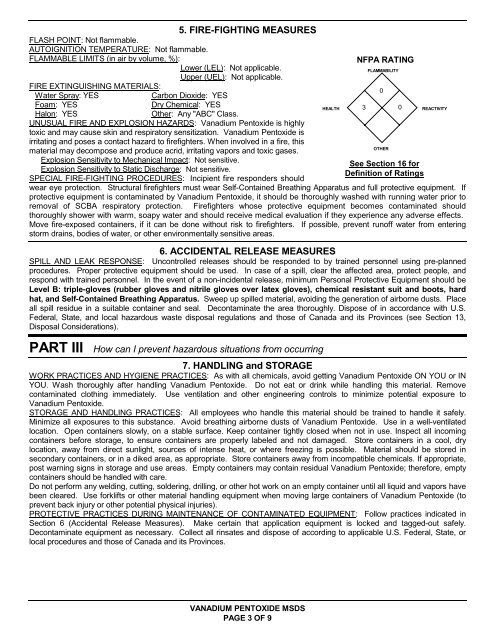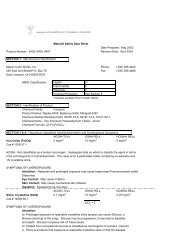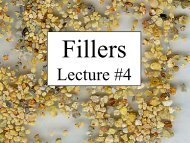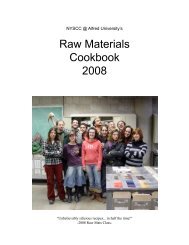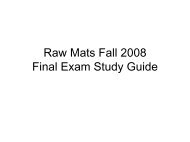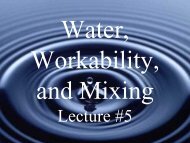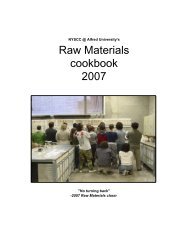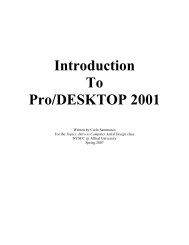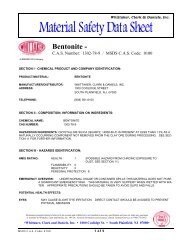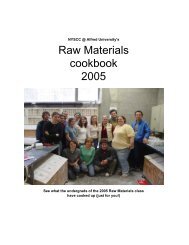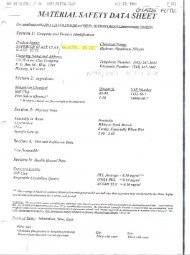Vanadium Pentoxide.pdf - Clay Planet
Vanadium Pentoxide.pdf - Clay Planet
Vanadium Pentoxide.pdf - Clay Planet
You also want an ePaper? Increase the reach of your titles
YUMPU automatically turns print PDFs into web optimized ePapers that Google loves.
5. FIRE-FIGHTING MEASURESFLASH POINT: Not flammable.AUTOIGNITION TEMPERATURE: Not flammable.FLAMMABLE LIMITS (in air by volume, %):Lower (LEL): Not applicable.Upper (UEL): Not applicable.FIRE EXTINGUISHING MATERIALS:Water Spray: YESCarbon Dioxide: YESFoam: YESDry Chemical: YESHalon: YESOther: Any "ABC" Class.UNUSUAL FIRE AND EXPLOSION HAZARDS: <strong>Vanadium</strong> <strong>Pentoxide</strong> is highlytoxic and may cause skin and respiratory sensitization. <strong>Vanadium</strong> <strong>Pentoxide</strong> isirritating and poses a contact hazard to firefighters. When involved in a fire, thismaterial may decompose and produce acrid, irritating vapors and toxic gases.Explosion Sensitivity to Mechanical Impact: Not sensitive.Explosion Sensitivity to Static Discharge: Not sensitive.SPECIAL FIRE-FIGHTING PROCEDURES: Incipient fire responders shouldwear eye protection. Structural firefighters must wear Self-Contained Breathing Apparatus and full protective equipment. Ifprotective equipment is contaminated by <strong>Vanadium</strong> <strong>Pentoxide</strong>, it should be thoroughly washed with running water prior toremoval of SCBA respiratory protection. Firefighters whose protective equipment becomes contaminated shouldthoroughly shower with warm, soapy water and should receive medical evaluation if they experience any adverse effects.Move fire-exposed containers, if it can be done without risk to firefighters. If possible, prevent runoff water from enteringstorm drains, bodies of water, or other environmentally sensitive areas.6. ACCIDENTAL RELEASE MEASURESSPILL AND LEAK RESPONSE: Uncontrolled releases should be responded to by trained personnel using pre-plannedprocedures. Proper protective equipment should be used. In case of a spill, clear the affected area, protect people, andrespond with trained personnel. In the event of a non-incidental release, minimum Personal Protective Equipment should beLevel B: triple-gloves (rubber gloves and nitrile gloves over latex gloves), chemical resistant suit and boots, hardhat, and Self-Contained Breathing Apparatus. Sweep up spilled material, avoiding the generation of airborne dusts. Placeall spill residue in a suitable container and seal. Decontaminate the area thoroughly. Dispose of in accordance with U.S.Federal, State, and local hazardous waste disposal regulations and those of Canada and its Provinces (see Section 13,Disposal Considerations).PART III How can I prevent hazardous situations from occurring7. HANDLING and STORAGEWORK PRACTICES AND HYGIENE PRACTICES: As with all chemicals, avoid getting <strong>Vanadium</strong> <strong>Pentoxide</strong> ON YOU or INYOU. Wash thoroughly after handling <strong>Vanadium</strong> <strong>Pentoxide</strong>. Do not eat or drink while handling this material. Removecontaminated clothing immediately. Use ventilation and other engineering controls to minimize potential exposure to<strong>Vanadium</strong> <strong>Pentoxide</strong>.STORAGE AND HANDLING PRACTICES: All employees who handle this material should be trained to handle it safely.Minimize all exposures to this substance. Avoid breathing airborne dusts of <strong>Vanadium</strong> <strong>Pentoxide</strong>. Use in a well-ventilatedlocation. Open containers slowly, on a stable surface. Keep container tightly closed when not in use. Inspect all incomingcontainers before storage, to ensure containers are properly labeled and not damaged. Store containers in a cool, drylocation, away from direct sunlight, sources of intense heat, or where freezing is possible. Material should be stored insecondary containers, or in a diked area, as appropriate. Store containers away from incompatible chemicals. If appropriate,post warning signs in storage and use areas. Empty containers may contain residual <strong>Vanadium</strong> <strong>Pentoxide</strong>; therefore, emptycontainers should be handled with care.Do not perform any welding, cutting, soldering, drilling, or other hot work on an empty container until all liquid and vapors havebeen cleared. Use forklifts or other material handling equipment when moving large containers of <strong>Vanadium</strong> <strong>Pentoxide</strong> (toprevent back injury or other potential physical injuries).PROTECTIVE PRACTICES DURING MAINTENANCE OF CONTAMINATED EQUIPMENT: Follow practices indicated inSection 6 (Accidental Release Measures). Make certain that application equipment is locked and tagged-out safely.Decontaminate equipment as necessary. Collect all rinsates and dispose of according to applicable U.S. Federal, State, orlocal procedures and those of Canada and its Provinces.HEALTHNFPA RATING3FLAMMABILITY0OTHERSee Section 16 forDefinition of Ratings0REACTIVITYVANADIUM PENTOXIDE MSDSPAGE 3 OF 9


